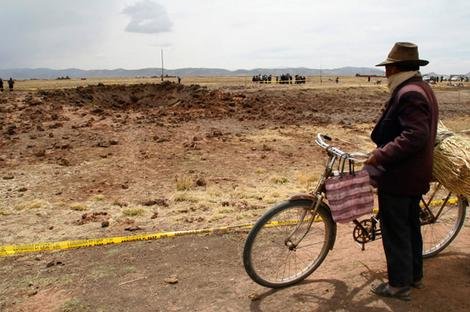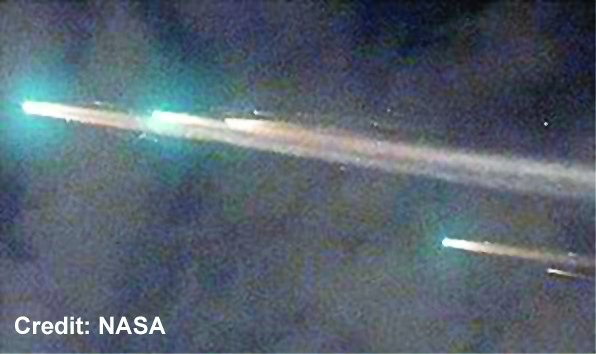|
Fire from the Sky On September 20th, 2007, a meteorite streaked across the Peruvian sky and slammed into a desolate plain close to the Bolivian border, close to Lake Titicaca. It left a crater more than 40 feet wide and 15 feet deep. Water that pooled in the depression, according to eyewitnesses, boiled for over 10 minutes. Reports from the area claimed that many locals had fallen ill after visiting the crater, displaying symptoms such as nausea, respiratory problems and headaches.
Scientists from Peruís Geophysics Institute arrived on the scene and confirmed that the crater had been made by a meteorite, finding magnetic fragments of meteoric iron. Medical teams, however, could find no trace of the illness reported, but they took samples of hair, blood and urine for analysis. A day later, National Geographic reported that the impactor was a rocky meteorite. They gleaned this information from Peru's Mining, Metallurgy, and Geology Institute (INGEMMET), who said the samples they received contained no iron. Most rock meteors burn up or break apart before they hit the ground, thus becoming meteorites, but this one didnít. The Peruvian scientists said that the impact created a column of steam to rise into the air. This steam was contaminated with arsenic, which is found in the soil and groundwater of the region. This, they said, was likely the cause of the illnesses. However, Lionel Jackson, of the Canadian Geological Survey, speaking to New Scientist, said that the illnesses were probably psychosomatic and that the locals were shocked by ďa big explosion in a very quiet area of the world.Ē It now seems certain that it was a meteorite that hit this isolated area of South America, but some of the early theories included geological venting causing an eruption or a top secret satellite crashing to the ground. Of course, the Earth is struck by celestial objects all of the time. It always has been and it always will be. At the beginning of 2007, a lump of metal fell into a New Jersey house and was generally agreed to be of meteoric origin, although theories ranged from an airplane part to an errant tool dropped by an astronaut! Probably the most famous impact in history is that of the Tunguska blast of 1908. On June 30th of that year, a huge fireball tore across the skies of Siberia and exploded above the Tunguska river. Over 600 square miles of taiga forest were flattened by the blast, and although there were likely to be many animal deaths, no humans were reportedly killed, save for one trapper who died from an infection contracted into his broken arm caused by the blast. Many theories have been expounded for what caused the blast, ranging from a flare from passing a comet, to a rocky asteroid exploding in the atmosphere, to a mini black hole, to a nuclear explosion, to a Tesla death ray, to a UFO. The general consensus is that an asteroid or comet fragment exploded high in the atmosphere and caused the devastation below without leaving a crater. One thing is certain, though: had the event happened a few hours later, the city of St Petersburg would have been devastated. In 1871, a huge fire swept through the city of Chicago in the United States. Over 200 people lost their lives and the city was devastated. The official explanation was that the fire was deliberately started, but in 2004, physicist, Robert Wood, suggested that the fires may have begun as a result of the break-up of Bielaís Comet. Several other fires started at the same time as the one in Chicago all over the American Midwest and over 2000 people died. In the 1930s, South America suffered two large events, one named the Rio Curaca Event, which took place on the Peru/Brazil border in 1931 and the Rupununi Event, which happened in British Guiana (now Guyana) in 1935. The Rio Curaca object allegedly set the forest on fire, which blazed for months and depopulated a wide area. Afterwards, a fine, white ash descended on the region. Two years after the Rupununi incident, an American expedition to British Guyana found an area of forest that had been virtually flattened by some huge explosion. Reports from the time of the event indicated that something had fallen from the sky and exploded over the jungle, flattening trees for up to twenty miles around. Of course, most meteorite impacts are not this large. Many rocks Ďsoft-landí, leaving no crater or only a small depression in the ground. Indeed, there are meteor fields all over the world, where enthusiasts can go and hunt for space rocks that are simply scattered about the ground. Not everything that hits the ground is natural. The NASA space station, Skylab, fell to Earth in 1979. While most of its 75 tons broke apart and fell into the Indian Ocean, off Western Australia, some fragments were found on land. In 1978 and 1983, two, nuclear-powered Soviet satellites crashed to Earth in Canada and the South Atlantic Ocean respectively. Cosmos 954 crashed into Northern Canada in 1978 and the resulting cleanup had the Canadian government issuing the Soviet Union with a bill for over $6 million, of which they paid half after three years of negotiations. In 1982, Cosmos 1402 was launched, but a malfunction caused its orbit to decay and it crashed into the ocean less than seven months later. Both of these incidents illustrate the dangers of using nuclear reactors for powering satellites and space probes. If a mission goes awry, as they sometimes do, then radioactive material might be released into the atmosphere, or contaminate the area where they fell, be that ocean or ground. In 2001, the 130-ton Mir space station was deliberately de-orbited and it burned up in the atmosphere over the Pacific Ocean. About 80 tons of the station crashed into the sea, with some fragments the size of a small car.
The Kecksburg Incident of December, 1965, is one of the most famous in UFO lore. A bell or acorn-shaped object was seen to come down in the woods close to the town of Kecksburg, Pennsylvania. While the media said it was a meteor or Soviet satellite that had crashed, eyewitnesses reported that the craft was intact and that the military arrived very quickly to remove it, although the Pentagon announced that nothing had been found. In 2005, NASA claimed that they had studied fragments from the Kecksburg object and concluded that it was a Soviet satellite that came down. This directly contradicts the earlier statement that nothing had been found, because if nothing had been found, where did the fragments that NASA analyzed come from? With all of these natural and artificial objects (whether man-made or not!) falling to the ground, one might be forgiven for proclaiming that the sky is falling. While this may not be true in a literal sense, it is true that it is not a matter of IF we will be hit again, but of WHEN. Indeed, it is often stated that we are overdue a large impact event of at least the Tunguska Eventís magnitude, with those predicted at least once every 50-100 years. Larger impacts, such as the strike that ended the Cretaceous period 65 million years ago, are thankfully less common, but we may also be overdue for a strike of that size by between 15 to 20 million years! © Steve Johnson 2007 (Article originally appeared in the November/December 2007 issue of UFO Data Magazine) |

